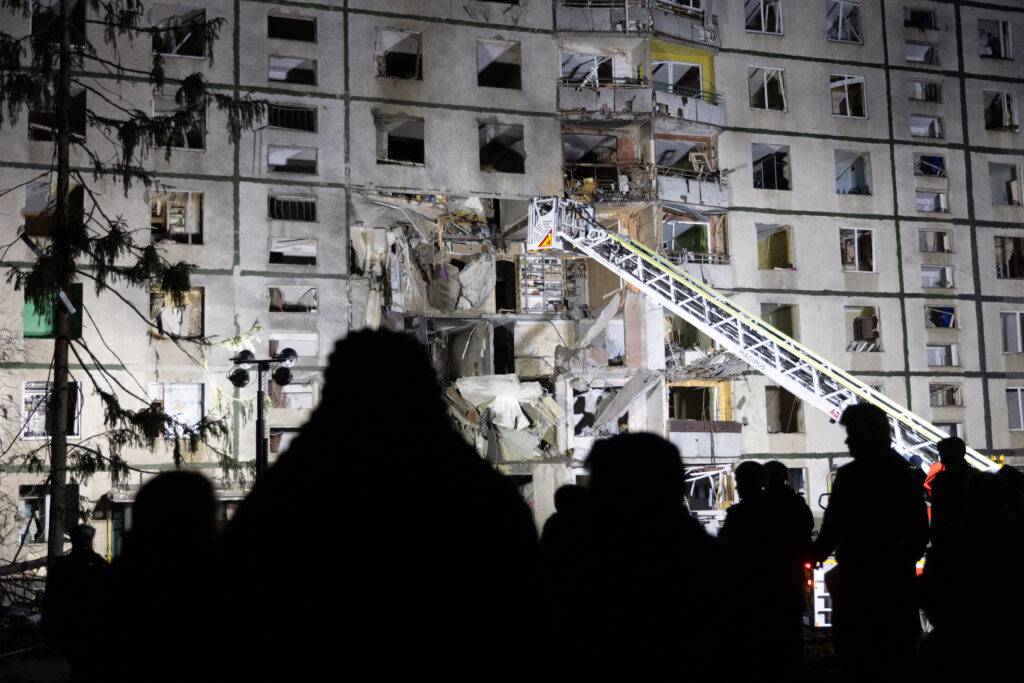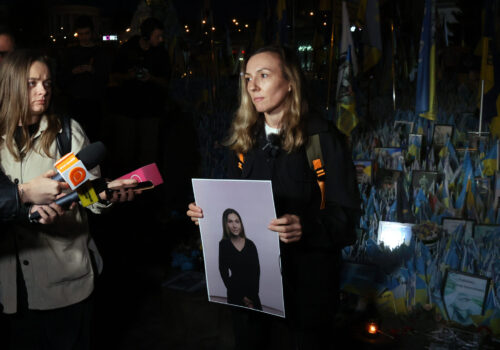Media coverage of Ukraine must balance public interest and victim privacy
Never before have the horrors of war been seen by so many, so quickly, so far away. In the digital age, photos and videos spread around the world on the internet in almost real time. Ukraine’s fight against Russian aggression is no exception; few other armed conflicts have been accompanied by such a vast amount of digital media coverage. For Ukrainians, the information component is crucial—it helps attract international support and informs the world about the horrors of war and the crimes committed by the aggressor.
At the same time, communicating news about war crimes and the victims of Russian violence balances on the fine line between the public interest and the right to privacy of those affected. The shocking photos and videos that appear in the aftermath of each round of Russian shelling draw attention, but how should journalists consider the potential consequences of publishing such material for the victims themselves?
To ensure that media coverage of conflict victims does not violate their privacy rights and further contribute to their trauma, a set of guidelines for reporting on war victims should be put in place, and journalists should make a good faith effort to obtain informed consent before publishing their stories and images.
Debates about boundaries
In the context of the ongoing conflict, the debate is deeply personal for many Ukrainians.
“If fate decrees that a rocket or something else hostile kills me, then I give permission in advance, with full awareness, for my photos—before and after my death—to be shared anywhere and as much as required,” Ukrainian communications expert Yaryna Klyuchkovska wrote on Facebook in early September.
“If I end up in a coma in the hospital, and all my relatives die—please forget about me and don’t touch me. Don’t post my pictures. . . . I am a psychologically weak person and will not care about your effectiveness in the international media,” responded Ukrainian writer and journalist Bogdan Logvynenko.
On September 4, Lviv was struck by Russian shelling, resulting in the deaths of nine people, including the Bazylevych family. The mother and her three daughters were among the dead, leaving only Yaroslav Bazylevych, their husband and father, alive. Photographs of a grief-stricken and wounded Yaroslav at the site of the shelling quickly spread across Ukrainian media. These images circulated widely, including among international media.
Almost immediately, a public debate broke out: How permissible is it for media outlets to publish photos of people who have just become victims of such barbaric crimes, at the very site where the crime occurred, and in their initial moments of shock? Does such publication adhere to media ethics, standards of the right to privacy, and respect for victims?
Proponents of publishing the photos argue that these images serve as documentation of Russian war crimes, both for the historical record and for the purposes of ensuring accountability for the perpetrators. The images are also intended not just for a domestic audience, but primarily for an international one. Proponents argue that such stories and visuals serve as reminders of the war in Ukraine and help gain international support for Kyiv.
On the other hand, critics argue that such publications could inflict additional suffering on the victims and contribute to their re-traumatization. Publishing photos of individuals in a state of shock, they argue, is a severe invasion of their privacy, even in the extreme context of war.
The situation in Lviv—where the photos of the victim were taken at the direct scene of the war crime—was not the first to occur during the armed conflict. Photos and videos of victims of Russian shelling, the shooting of Ukrainian prisoners of war, and other war crimes have repeatedly caused shockwaves in the Ukrainian media space.
However, the widespread focus on Bazylevych sparked especially intense debates about the ethics of such practices. At the funeral of the mother and children a few days later, media attention focused on Yaroslav’s personal tragedy, with photos and videos of him again circulating in the media and on social networks.
The media coverage of conflict in the digital age can help prevent crimes and bring perpetrators to justice. But coverage of the victims and survivors of war crimes can also cause victims further suffering and contribute to their re-traumatization. In this context, journalists carry an increased level of professional responsibility.
“We need to learn to maneuver between carefully preserving events and names and picking at the open wounds of relatives with red-hot iron. Between documenting crimes and savoring someone else’s grief. Because, of course, the world must know. Of course, we must know. But definitely not at the expense of those who have already given us and the world the most precious thing they had,” wrote Lesya Lytvynova, a veteran of the Armed Forces of Ukraine, a week and a half later, commenting on the Bazylevych family tragedy and similar cases.
In his later comment to the Washington Post, Bazylevych recognized both the difficulty and importance of such broad media coverage: “It’s very difficult to see all of the attention and news on our family out there, but it’s also important”.
One of the problems is that no universal legal or ethical rules exist for journalists in these wartime situations; international standards mainly prioritize journalists’ safety and professional protections over guidance on how and when to depict victims of armed conflict.
Setting standards for reporting on the victims of war
Some guidelines for how to report on the victims of war do exist, including the Code for the Coverage of the Colombian Armed Conflict, which was developed by Colombian journalists in 2003. The document states that “We will respect the privacy of citizens involved in or affected by the armed conflict, provided that this silence will not compromise the public interest. In all instances we will respect the grief of the victims.” In addition, there are recognized standards for how journalists should cover victims of crimes or people who cannot give informed consent to the press. These include standards for covering cases of violence against women and girls, interviewing trafficked women, and reporting on children.
For instance, in Europe, the practice of the European Court of Human Rights provided guidance in Dupate v. Latvia on the limits of distributing visuals of individuals in a state of reduced self-control, even when the circumstances are of public interest.
The balance between public interest and victims’ right to privacy can serve as the key criterion for determining the permissibility of sharing media featuring individuals in a state of shock after a war crime.
The Commission on Journalistic Ethics, a Ukrainian organization, reached similar conclusions in its recommendations based on its review of this situation in September 2024:
“Media intrusions, including close-ups of a man who survived the shooting, are legally excessive. Even if individuals in a fragile psychological state give consent for filming and publication, they may not always be fully aware of their actions. In such cases, the portrayal of their suffering mainly serves one purpose—to satisfy the emotional curiosity of the information consumer.”
Ukraine’s tragic experience offers an important opportunity to reassess the media’s approach to reporting on conflict victims from both legal and ethical perspectives. Currently, Ukrainian media outlets are trying to align with the standards of major international outlets like the BBC and Reuters. However, this experience also provides a foundation for developing standards on covering war crimes that balance freedom of speech with respect for victims’ privacy.
Building on the earlier recommendations, here are three important questions that journalists and editors should answer before publishing material on war crime victims:
- Does the public interest necessitate the publication of an entire series of photos and videos? Would it be sufficient to share a single image or present the information in a more restrained manner (e.g. blurring faces, using initials, not specifying sensitive details, etc.)?
- Is it necessary to publish such materials in the immediate aftermath of the tragedy? Would waiting a few days, when victims can provide informed consent, diminish its impact?
- Is the publication in the public interest, rather than solely for increasing media coverage and visibility, and is the material presented in a way that minimizes the risk of secondary trauma and re-traumatization?
Of course, each case is unique, and the decision to publish may vary depending on the specific context. But without seriously considering these questions, media coverage of Ukraine risks shifting the focus of the publication from the fact of the crime and its consequences to how the victims experience these events, highlighting their emotions and behavior at different moments. And in the absence of the victims’ consent to publish these stories and photos, such publications risk exposing victims to “public curiosity”—a practice broadly prohibited by international humanitarian law, including the Geneva Conventions, for the protection of victims of war.
Obviously, there is no universal set of criteria for deciding whether and when to publicize the stories and images of victims of conflict. However, at a time when information can be spread instantly, a responsible, victim-centered approach will require journalists to make a good faith effort to obtain informed consent from victims before publishing their photos and stories. Respect for the choice of victims is fundamental. Victims of the war in Ukraine have already been deprived of their choices by Russia’s aggression. They have the right to choose whether they want their stories to be publicized.
Ivan Horodyskyy is a nonresident senior fellow with the Atlantic Council’s Strategic Litigation Project and cofounder of the Dnistryanskyi Center for Politics and Law.
Further reading
Tue, Oct 29, 2024
Putin’s war on Ukrainian heritage: Russia bombs first Soviet skyscraper
UkraineAlert By Peter Dickinson
This week’s targeted Russian bombing of Kharkiv’s iconic Derzhprom building was the latest in a series of attacks on Ukrainian heritage sites that many regard as evidence of a deliberate Kremlin campaign to erase Ukraine’s national identity, writes Peter Dickinson.
Tue, Oct 22, 2024
Ukrainian journalist who exposed Russian occupation dies in Kremlin captivity
UkraineAlert By Mercedes Sapuppo
The death of Ukrainian journalist Victoria Roshchyna in Kremlin custody serves as a chilling reminder of the war crimes being committed throughout Russian-occupied Ukraine, writes Mercedes Sapuppo.
Tue, Oct 29, 2024
Putin is creating the conditions for Russian victory in Ukraine
UkraineAlert By Mykola Bielieskov
Whoever wins the US presidential election, they will inherit a war in Ukraine that requires their urgent attention to prevent a Russian victory that would signal the decline of the West and transform the geopolitical landscape, writes Mykola Bielieskov.
Image: Ukrainian rescuers working at the site of the Russian glide-bomb attack on a nine-flour residential building in Kharkiv, Ukraine, October 30, 2024 amid the ongoing Russian invasion. At least 29 people were injured and a child was killed, according to a post by Kharkiv Military Administration Oleg Synegubov on his telegram channel. Photo by Yevhen Titov/ABACAPRESS.COM




